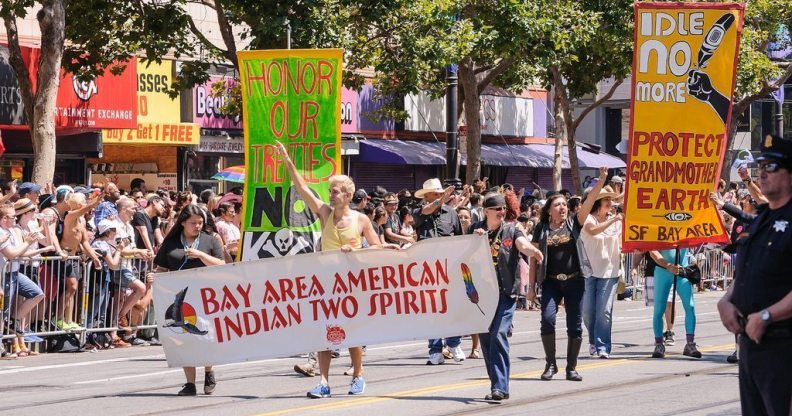What is Two Spirit? The term used by indigenous North American and First Nations people with masculine and feminine spirits

The Two Spirit contingent marches at San Francisco Pride in 2014. (Wiki Commons)
The Two Spirit contingent marches at San Francisco Pride in 2014. (Wiki Commons)
Two Spirit is a term used by non-binary Indigenous North American and First Nations people to represent those who possess masculine and feminine spirits.
Although Two-Spirited people are described throughout history, the term was coined at the “Third Annual Inter-tribal Native American, First Nations Gay and Lesbian American Conference” in 1990 in Winnipeg, Canada.
It was chosen as a means of unifying the different gender identities and expressions of Native American, First Nations and Indigenous people.

The Two Spirit contingent marches at San Francisco Pride in 2014 (Wiki Commons)
In the book Queer Indigenous Studies, the authors explain the term Two Spirit is not only a description of gender identities, but “a contemporary interlinking of gender, sexuality, spirituality, and social roles.”
Two Spirit is an umbrella term
Although the term is widely accepted among different Indigenous communities, most have specific terms in their own languages to describe gender-variant members.
The academic Brian Joseph Gilley, author of Becoming Two-Spirit: Gay Identity and Social Acceptance in Indian Country, has said the term for Two Spirit is “different in each tribal language.”
Related: Piers Morgan claims gender-fluid people are ‘damaging to society’

A Two Spirit trolley at San Francisco Pride (Wiki Commons)
The term Two Spirit has also replaced the word “berdache” – which was assigned to non-binary people by European settlers who colonised the region and is largely considered inappropriate and offensive.
Learn more about non binary people by clicking here.
In 2012, a marker dedicated to Two Spirit people was added to the Legacy Walk in Chicago, which celebrates LGBT history and people.
Why it is specific to North American Indigenous cultures
Two Spirit is a spiritual and sacred term that comes with a long history and heritage within native North American cultures, such as the First Nations people in Canada, which means it can only be used in context with such cultures.
Author and academic Michelle Cameron, who has written on the cultural appropriation of the term Two Spirit, has said it has a “specific cultural context” and removing it from that context is “an act of colonisation and must be resisted.”
“Two-spirited is a reclaimed term designed by Aboriginals to define our unique cultural context, histories, and legacy,” she writes.

Two Spirit is “an interlinking of gender, sexuality, spirituality, and social roles” (Getty)
Related: Portugal passes law to let trans people self-identify their legal gender
“When people do not see the harm in ‘sharing’ the term, they are missing the point and refusing to recognise that by appropriating the term they will inevitably alter its cultural context.”
Marginalisation of Two Spirit people
Discrimination persists towards Indigenous people who identify as lesbian, gay, bisexual, queer, transgender, queer and Two Spirit.
Homophobia, transphobia, cisnormativity – the assumption that all people are cisgender – and heteronormativity – the idea that binary gender identity and heterosexual orientation are the norm – all contribute to the marginalisation of Two-Spirited people.
These factors also prevent many people from access to health services, according to the Canadian Rainbow Health Coalition.
A 2009 study of the health and safety of Two Spirit people in Manitoba found many are frequently exposed to violence and hostility, with a high proportion living in poverty or near-poverty.
Studies have also shown that Two Spirit women are disproportionately affected by discrimination and abuse.
Related: Why ‘rapid-onset gender dysphoria’ is bad science
Last year, Jamie Lee Wounded Arrow, a Two Spirit woman originally from the Pine Ridge reservation who belonged to the Oglala Lakota tribe, was killed in her home in South Dakota.
The issue of violence against Two Spirit people was also addressed in the 2009 documentary film Two Spirits, directed by Lydia Nibley, which tells the story of the murder of 16-year-old Fred Martinez, a Two Spirit student of Navajo ancestry.
In 2001, Martinez beaten was with a rock and left to die in Cortez, Colorado, in what activists called a hate-motivated crime.

